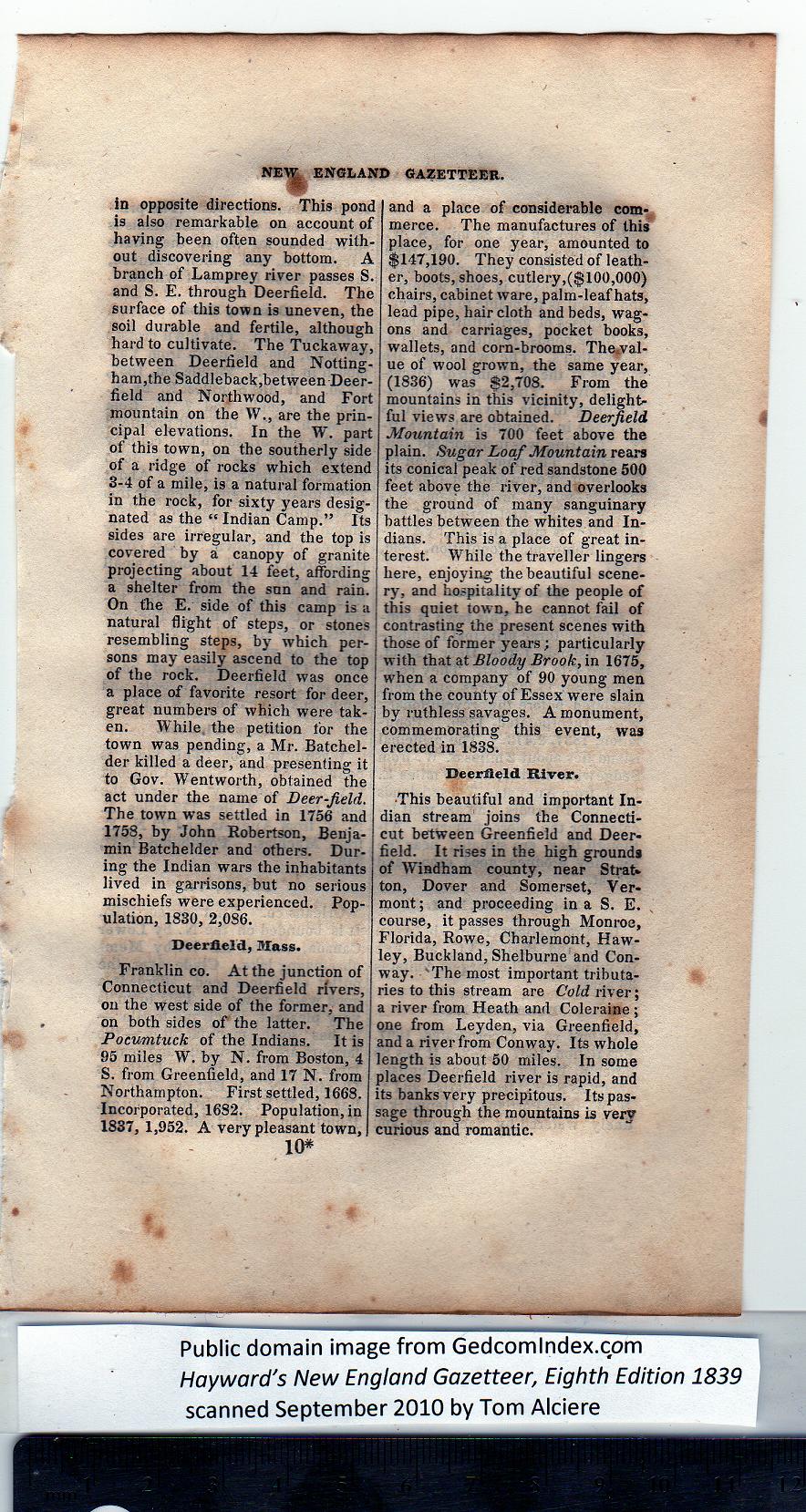|
in opposite directions. This pond
is also remarkable on account of
having been often sounded with-
out discovering any bottom. A
branch of Lamprey river passes S.
and S. E. through Deerfield. The
surface of this town i9 uneven, the
soil durable and fertile, although
hard to cultivate. The Tuckaway,
between Deerfield and Notting-
ham,the Saddleback,between Deer-
field and Northwood, and Fort
mountain on the W., are the prin-
cipal elevations. In the W. part
of this town, on the southerly side
of a ridge of rocks which extend
3-4 of a mile, is a natural formation
in the rock, for sixty years desig-
nated as the “ Indian Camp.” Its
side9 are irregular, and the top is
covered by a canopy of granite
projecting about 14 feet, affording
a shelter from the sun and rain.
On the E. side of this camp is a
natural flight of steps, or stones
resembling steps, by which per-
sons may easily ascend to the top
of the rock. Deerfield was once
a place of favorite resort for deer,
great numbers of which were tak-
en. While, the petition for the
town was pending, a Mr. Batchel-
der killed a deer, and presenting it
to Gov. Wentworth, obtained the
act under the name of Deer-field.
The town w*as settled in 1756 and
1758, by John Robertson, Benja-
min Batchelder and others. Dur-
ing the Indian wars the inhabitants
lived in garrisons, but no serious
mischiefs were experienced. Pop-
ulation, 1830, 2,086.
Deerfield, Mass. |
Franklin co. At the junction of
Connecticut and Deerfield rivers,
on the west side of the former, and
on both sides of the latter. The
Pocumtuck of the Indians. It is
95 miles W. by N. from Boston, 4
S. from Greenfield, and 17 N. from
Northampton. First settled, 1668.
Incorporated, 1682. Population, in
1837, 1,952. A very pleasant town,
10*
and a place of considerable com-
merce. The manufactures of this
place, for one year, amounted to
$147,190. They consisted of leath-
er, boots, shoes, cutlery,($100,000)
chairs, cabinet ware, palm-leaf hats,
lead pipe, haircloth and beds, wag-
ons and carriages, pocket books,
wallets, and corn-brooms. The«yal-
ue of wool grown, the same year,
(1836) was $2,708. From the
mountains in this vicinity, delight-
ful views are obtained. Deerfield
Mountain is 700 feet above the
plain. Sugar Loaf Mountain rears
its conical peak of red sandstone 500
feet above the river, and overlooks
the ground of many sanguinary
battles between the whites and In-
dians. This is a place of great in-
terest. While the traveller lingers
here, enjoying the beautiful scene-
ry, and hospitality of the people of
this quiet tow n, he cannot fail of
contrasting the present scenes with
those of former years; particularly
with that at Bloody Brook, in 1675,
when a company of 90 young men
from the county of Essex were slain
by ruthless savages. A monument,
commemorating this event, was
erected in 183S.
Deerfield River.
•This beautiful and important In-
dian stream joins the Connecti-
cut between Greenfield and Deer-
field. It rises in tbe high grounds
of Windham county, near Strat-
ton, Dover and Somerset, Ver-
mont; and proceeding in a S. E.
course, it passes through Monroe,
Florida, Rowe, Charlemont, Haw-
ley, Buckland, Shelburne and Con-
way. The most important tributa-
ries to this stream are Cold river;
a river from Heath and Coleraine ;
one from Leyden, via Greenfield,
and a river from Conway. Its whole
length is about 50 miles. In some
places Deerfield river is rapid, and
its banks very precipitous. Its pas-
sage through the mountains is very
curious and romantic. |
